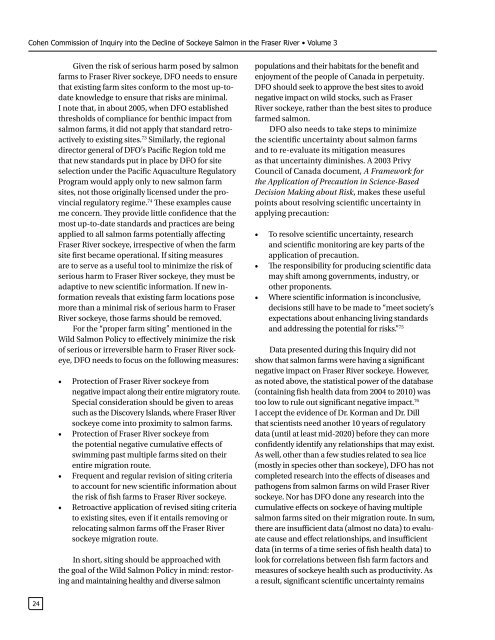CP32-93-2012-3-eng.pdf
CP32-93-2012-3-eng.pdf
CP32-93-2012-3-eng.pdf
You also want an ePaper? Increase the reach of your titles
YUMPU automatically turns print PDFs into web optimized ePapers that Google loves.
Cohen Commission of Inquiry into the Decline of Sockeye Salmon in the Fraser River • Volume 3<br />
Given the risk of serious harm posed by salmon<br />
farms to Fraser River sockeye, DFO needs to ensure<br />
that existing farm sites conform to the most up-todate<br />
knowledge to ensure that risks are minimal.<br />
I note that, in about 2005, when DFO established<br />
thresholds of compliance for benthic impact from<br />
salmon farms, it did not apply that standard retroactively<br />
to existing sites. 73 Similarly, the regional<br />
director general of DFO’s Pacific Region told me<br />
that new standards put in place by DFO for site<br />
selection under the Pacific Aquaculture Regulatory<br />
Program would apply only to new salmon farm<br />
sites, not those originally licensed under the provincial<br />
regulatory regime. 74 These examples cause<br />
me concern. They provide little confidence that the<br />
most up-to-date standards and practices are being<br />
applied to all salmon farms potentially affecting<br />
Fraser River sockeye, irrespective of when the farm<br />
site first became operational. If siting measures<br />
are to serve as a useful tool to minimize the risk of<br />
serious harm to Fraser River sockeye, they must be<br />
adaptive to new scientific information. If new information<br />
reveals that existing farm locations pose<br />
more than a minimal risk of serious harm to Fraser<br />
River sockeye, those farms should be removed.<br />
For the “proper farm siting” mentioned in the<br />
Wild Salmon Policy to effectively minimize the risk<br />
of serious or irreversible harm to Fraser River sockeye,<br />
DFO needs to focus on the following measures:<br />
• Protection of Fraser River sockeye from<br />
negative impact along their entire migratory route.<br />
Special consideration should be given to areas<br />
such as the Discovery Islands, where Fraser River<br />
sockeye come into proximity to salmon farms.<br />
• Protection of Fraser River sockeye from<br />
the potential negative cumulative effects of<br />
swimming past multiple farms sited on their<br />
entire migration route.<br />
• Frequent and regular revision of siting criteria<br />
to account for new scientific information about<br />
the risk of fish farms to Fraser River sockeye.<br />
• Retroactive application of revised siting criteria<br />
to existing sites, even if it entails removing or<br />
relocating salmon farms off the Fraser River<br />
sockeye migration route.<br />
In short, siting should be approached with<br />
the goal of the Wild Salmon Policy in mind: restoring<br />
and maintaining healthy and diverse salmon<br />
populations and their habitats for the benefit and<br />
enjoyment of the people of Canada in perpetuity.<br />
DFO should seek to approve the best sites to avoid<br />
negative impact on wild stocks, such as Fraser<br />
River sockeye, rather than the best sites to produce<br />
farmed salmon.<br />
DFO also needs to take steps to minimize<br />
the scientific uncertainty about salmon farms<br />
and to re-evaluate its mitigation measures<br />
as that uncertainty diminishes. A 2003 Privy<br />
Council of Canada document, A Framework for<br />
the Application of Precaution in Science-Based<br />
Decision Making about Risk, makes these useful<br />
points about resolving scientific uncertainty in<br />
applying precaution:<br />
• To resolve scientific uncertainty, research<br />
and scientific monitoring are key parts of the<br />
application of precaution.<br />
• The responsibility for producing scientific data<br />
may shift among governments, industry, or<br />
other proponents.<br />
• Where scientific information is inconclusive,<br />
decisions still have to be made to “meet society’s<br />
expectations about enhancing living standards<br />
and addressing the potential for risks.” 75<br />
Data presented during this Inquiry did not<br />
show that salmon farms were having a significant<br />
negative impact on Fraser River sockeye. However,<br />
as noted above, the statistical power of the database<br />
(containing fish health data from 2004 to 2010) was<br />
too low to rule out significant negative impact. 76<br />
I accept the evidence of Dr. Korman and Dr. Dill<br />
that scientists need another 10 years of regulatory<br />
data (until at least mid-2020) before they can more<br />
confidently identify any relationships that may exist.<br />
As well, other than a few studies related to sea lice<br />
(mostly in species other than sockeye), DFO has not<br />
completed research into the effects of diseases and<br />
pathogens from salmon farms on wild Fraser River<br />
sockeye. Nor has DFO done any research into the<br />
cumulative effects on sockeye of having multiple<br />
salmon farms sited on their migration route. In sum,<br />
there are insufficient data (almost no data) to evaluate<br />
cause and effect relationships, and insufficient<br />
data (in terms of a time series of fish health data) to<br />
look for correlations between fish farm factors and<br />
measures of sockeye health such as productivity. As<br />
a result, significant scientific uncertainty remains<br />
24
















